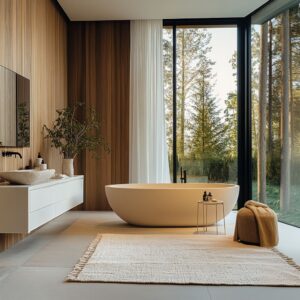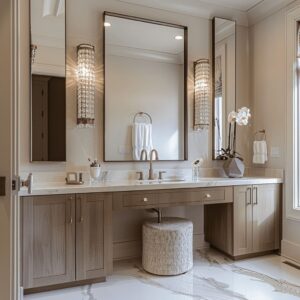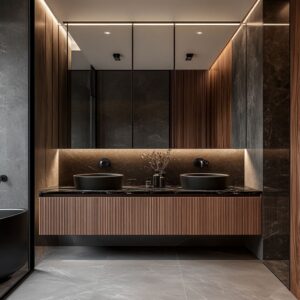Fancy bathrooms aren’t made by loading up on decoration—they’re shaped by decisions that layer, reflect, and align. In high-end spaces, the feeling of richness comes from how each surface interacts with another, not from any single standout object.
Light moves differently when it hits curved glass, ribbed marble, or a soft shadow under a floating bench.
Shapes feel intentional, even when they’re off-center. In some layouts, a window view might serve the role of artwork, framed by thin mullions and a stone ledge that meets the sill.
Elsewhere, veining in stone is angled just enough to pull the eye across a wall.
These quiet techniques are what define the mood of fancy master bathrooms and fancy powder room ideas—where restraint is part of the aesthetic, and every detail is doing visual work without announcing itself. This article looks at the specific visual moves that create that impression of calm richness, all without slipping into excess.
Drama Through Optical Layering
Some of the most memorable spaces rely on how surfaces interact—not by standing alone, but by playing off one another in quiet combinations. A glowing stone wall isn’t the final statement; it’s often paired with a shimmering pendant, a basin carved from translucent mineral, or a brushed metal element that catches light without overpowering.
These combinations don’t rely on bulk or quantity—they rely on depth. That’s what gives many fancy bathroom ideas their sense of richness.
Before the shape is even registered, the eye picks up on light passing through layers, reflections bouncing between textures, and a soft interplay of contrast. The impression is more than surface-deep, yet never crowded.
Slimmed‑Down Symmetry
What appears balanced at first often hides a small shift. A mirror might stretch across two sinks but align slightly to the left.
A basin may be gently nudged to one side so that the view behind it shares attention. These design decisions don’t scream for notice.
Instead, they invite a second look. That tiny break in symmetry adds movement—an almost invisible pulse that keeps the eye active.
These aren’t flaws. They’re choices that give the room a lived-in precision.
In fancy bathroom design, this kind of asymmetry can suggest quiet control rather than perfection, and it often creates a better sense of rhythm across the room.
Curves as Soft Armor
There’s something calming about a room where no edge feels too sharp. Curved mirrors, gently rounded vanities, teardrop-shaped lights—these soften the room not only in form but in feel.
In many bathrooms, curves aren’t only used where expected. They’re found in pendant lines, mosaic arches, basin rims, and even the silhouette of recessed shelves.
These shapes ease transitions where dust and glare might otherwise gather. A curve does more than smooth a surface—it reframes the way light moves and settles, making the atmosphere feel more tactile.
These details are subtle, but they define the overall tone with quiet clarity.
Stone Treated Like Textile
In some of the most refined bathrooms, stone no longer plays the role of background support—it becomes a material that behaves like fabric. Ribbed marble panels give the appearance of pleated drapery, catching shadows in the grooves the way soft cloth folds do.
For example, book-matched peach onyx, with its mirrored veining, lays across surfaces like a silk panel, its movement more fluid than solid.
And in some mosaic compositions, especially in soft blue tones, narrow tiles are aligned in ways that recall woven ribbon, not hard flooring. These surfaces don’t sit still—they bend light, echo motion, and give the illusion of softness.
It’s this illusion that often shapes the foundation for fancy bathroom decorations, where the materials are selected not only for durability, but for how they shift character under changing light.
Shadow as Ornament
Rather than relying on carved moldings or gilded edges, many bathrooms achieve their richness through subtle absence. Cutouts under the vanity, recessed plinths, and softly glowing base lighting create shapes not by mass, but by shadow.
These gaps leave behind outlines that act like garment seams—tracing silhouettes without adding bulk.
The negative space around the furniture becomes a design feature, drawing quiet lines that separate each zone without harsh dividers. It’s an approach that whispers instead of declaring, using contrast between glow and dim to emphasize depth.
This method suits a fancy bathroom theme where visual weight is managed with care, and the luxury rests in the balance between shape and space.
Color Held to a Tight Bandwidth
The strongest color stories aren’t the loudest—they’re the most controlled. In many refined bathroom interiors, a single hue dominates the scene, yet plays out in multiple finishes.
One room might carry the same soft beige across matte walls, polished counters, and brushed fixtures.
Another works in a range of blush tones, letting pearly tile sit beside muted rose metal and soft pink glass. What keeps these spaces feeling composed is the way tone, texture, and sheen shift without breaking the palette.
These small contrasts within a narrow range build dimension more effectively than switching to an unrelated color. This approach defines the mood of many a fancy modern bathroom, where the interest doesn’t come from color variety, but from how each surface responds to light in its own way.
Nature Pulled Indoors by Framing
Instead of hanging art, some bathrooms use the view itself as the visual centerpiece. A garden or treetop scene doesn’t just provide light—it introduces texture, color, and motion without adding a single object.
Thin window frames help keep the focus outdoors, acting more like a subtle border than a divider. When the ledge of a tub aligns with the window base, the room starts to read like it’s part of the landscape.
In some fancy shower designs, the greenery beyond the glass becomes the accent wall. This is where luxury comes from quiet alignment, not ornament.
Decorative Silence in Hardware
Some of the richest-looking bathrooms don’t show off their fixtures. They use finishes that stay quiet—matte black, soft bronze, muted brass—tones that catch just enough light without stealing attention.
These aren’t accents meant to lead. They’re finishing moves that respect everything around them.
In spaces like these, restraint doesn’t feel empty. It feels settled.
The hardware fades into the palette, letting the stone, tile, or wood do the speaking. In some fancy small bathroom ideas, this silence is key to making the space feel thoughtful, not crowded.
Every choice shows care, even when it’s nearly invisible.
Micro‑Scale Sparkle
Instead of one large centerpiece light, sparkle can be spread across the room in small, shimmering touches. Air-bubble pendants give off flickers from every angle.
Mosaics with silver threads reflect softly under downlights. An aged mirror adds blur and glow with its worn surface.
These points of shine don’t compete—they scatter and layer. It’s the difference between one loud note and a hundred whispered ones.
This technique is often seen in fancy bathroom images where richness comes from texture, not size. The sparkle is never loud, but it lingers.
Furniture Tricks in Built‑Ins
In many refined bathrooms, permanent fixtures are built to feel like standalone furniture pieces. Benches stretch wall to wall but never touch the floor.
Vanities hover just above the surface, leaving a slim line of shadow that separates them from the wall behind. Even a tub platform might appear to slide into the architecture rather than being installed into it.
These floating details don’t demand attention—they allow light to pass under and around, which makes every form feel lighter.
This kind of precision is especially common in fancy master bathroom ideas, where visual openness adds more impact than square footage. The result is not bulky or overly present, but calm, structured, and unmistakably high-end.
Storytelling Through Vein Direction
In bathrooms that feel thoughtfully composed, stone surfaces do more than match—they lead the eye. Vertical tile veining can stretch a space upward, like tracing a skyline.
Horizontal travertine settles the gaze, setting a neutral rhythm before a statement feature unfolds.
Some marble runs diagonally across the wall, slicing through soft surroundings like a streak of movement, adding just the right tension behind something still—like an alabaster basin. These alignments are rarely random.
They map out a silent choreography, building flow through the placement of natural lines. In the most memorable images of fancy bathrooms, this kind of visual pathway adds motion without adding weight.
Key Takeaways for Fancy Appeal
Refinement in bathroom design doesn’t rely on excess—it comes from knowing what to hold back. One of the most effective tools is reflection: stacked mirrors, glass, and glossy surfaces that layer depth without bulk.
A slim dark line under a cabinet or along a niche might add more richness than an ornate frame. Narrowing the color palette and expanding finish variety inside that range keeps the room focused but textured.
Framed windows become artwork when greenery outside is allowed to fill the view. If there’s no view, a softly glowing slab of stone can become its own kind of scene.
Quiet finishes on hardware leave space for materials to speak. Sparkle can exist in the smallest doses—bubble glass, silver grout, oxidized mirrors—flickering without overwhelming.
Floating volumes remove heaviness and allow air and light to move freely. And stone veining, when placed with care, can act as the visual thread that ties the room together.
These quiet decisions build the kind of layered detail that makes even a small bathroom feel thoroughly composed—where every element is shaped by restraint, but never looks spare.
Disclaimer: This content is intended for informational and stylistic inspiration only. It does not constitute professional design advice.
For personalized recommendations, consult with a licensed interior designer or architect.



























